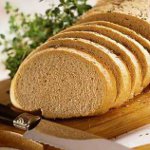What is a grain unit?
 When diabetes is very important to adhere toSpecial diet, regulating the intake of carbohydrates into the body. But the calculation of the carbohydrate content - it's pretty dreary. To facilitate this task, the German dieticians developed the so-called bread unit.
When diabetes is very important to adhere toSpecial diet, regulating the intake of carbohydrates into the body. But the calculation of the carbohydrate content - it's pretty dreary. To facilitate this task, the German dieticians developed the so-called bread unit.Bread unit is used to approximately estimate the amount of carbohydrates in a particular food product. One unit of bread equals 12 g of carbohydrates. If the grain itself is taken as the standard of the grain unit, 1 XE will be equal to 1 piece of bread. This amounts to 20 g of white bread or 25 Borodino or rye.
One grain unit increases the blood glucose level by an average of 2.77 mmol / l. To assimilate it, a short-acting insulin dose of 1.4 U is needed. Nutritionists advise to eat not more than 7 bread units per meal. The approximate daily amount of XE ranges from 6 to 30 and depends on body weight and physical activity.
It is calculated according to the following scheme. The daily norm of kcal is taken (about 2000 kcal for people with normal weight and 1800 kcal for people with excess weight). Find 55% of the daily rate - this is the amount of kcal, which must come into the body with carbohydrates. Since 1 g of carbohydrates gives the body 4 kcal, divide the figure by 4, we get a daily amount of carbohydrates. Divide it by 12 (the number of grams of carbohydrates in 1 XE) and get daily amount of XE.
Given that the daily norm of kcal depends not only on body weight, but also on age and type of activity, it is better to take advantage of ready table for determining the daily rate of bread units.
Daily table of grain units
| People with a shortage of weight or engaged in heavy physical labor | 25-30 HE |
| People with normal body weight who are engaged in manual labor of medium gravity | 20-22 HE |
| People with normal body weight, engaged in sedentary work | 15-18 HE |
| A typical patient with diabetes mellitus: age> 50 years, low level of physisic activity, BMI = 25-29 kg / m2 | 12-14 HE |
| People with fatigue degree 2A (BMI = 30-34.9 kg / m2) | 10 HE |
| People with obesity degree 2B (BMI = 35 kg / m2 and more) | 6-8 HE |
How to find out how many grain units containor other food product? There are special tables of grain units, which indicate the amount of XE for food. We will briefly list the most common products. So, one unit of bread is contained in as many products:
1 piece of bread, or 2 unsweetened breadcrumbs, or 5 crackers;
1 tbsp. bread crumbs, starch or flour;
2 tablespoons any cereal (boiled) or 1 tbsp. raw;
2-4 tablespoons boiled pasta (depends on the form);
7 tablespoons beans;
1 boiled potato, or 2 tablespoons. mashed potatoes, or 0.25 st. fried potatoes;
vegetables: 3 carrots or 1 beet (XE are taken into account when consuming 200 g or more);
berries: 1 tea saucer of strawberries / cherries, or 6-8 tablespoons. raspberries / currants / gooseberries / blueberries / lingonberries / blackberries, or 12 grapes;
half a grapefruit or a banana;
1 orange, or apple, or pear, or peach, or persimmon, or mango, or kiwi, or fig, or pomegranate;
3-4 plums, or apricot, or mandarin;
1 piece of pineapple (cross-section), or watermelon, or melon;
juice: 0.5 tbsp. apple or 0.3 st. grape;
drinks: 1 tbsp. kvass, or beer, or dry wine, or any unsweetened dairy product;
1 tbsp. of granulated sugar.
In principle, if you are dealing with products in factory packaging, you do not even need to use the table. On the packaging of any product indicate the amount of nutrients (carbohydrates) in 100 g. This number should be divided by 12 (get the number of XE in 100 g of product), and then adjust, based on the weight of the product.
The number of bread units in cooked dishes Count by prescription. To do this, add the bread units for each ingredient and divide by the number of portions obtained after cooking.
Exact adherence to diet in diabetes - a very important component of the well-being of the patient. Bread unit allows you to significantly simplify the diet.














